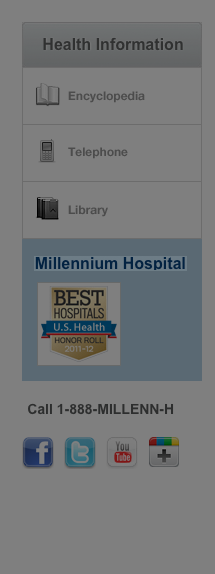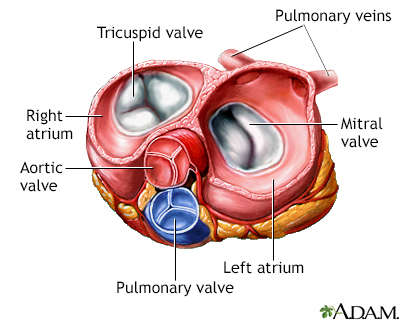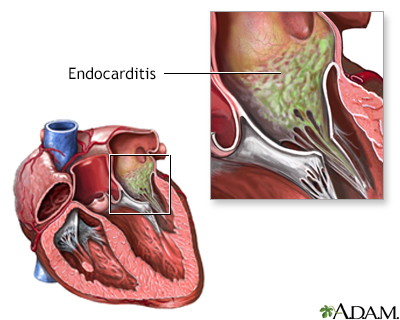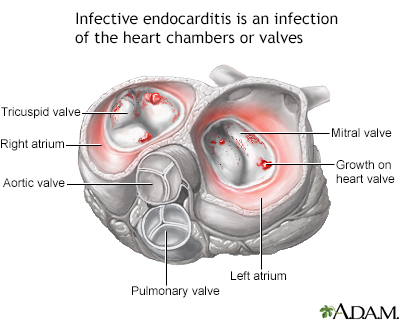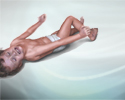Endocarditis - children
 Print-Friendly
Print-Friendly
Valve infection - children; Staphylococcus aureus - endocarditis - children; Enterococcus - endocarditis- children; Streptococcus viridians - endocarditis - children; Candida - endocarditis - children; Bacterial endocarditis - children; Infective endocarditis - children; Congenital heart disease - endocarditis - children
The inner lining of the heart chambers and heart valves is called the endocardium. Endocarditis occurs when this tissue becomes swollen or inflamed, most often due to infection at the heart valves.
I Would Like to Learn About:
Causes
Endocarditis occurs when germs enter the bloodstream and then travel to the heart.
- Bacterial infection is the most common cause
- Fungal infections are much more rare
- In some cases, no germs can be found after testing
Endocarditis can involve the heart muscle, heart valves, or lining of the heart. Children with endocarditis may have an underlying condition such as:
- Birth defect of the heart
- Damaged or abnormal heart valve
- New heart valve after surgery
The risk is higher in children who have a history of heart surgery, which can leave rough areas in the lining of the heart chambers.
This makes it easier for bacteria to stick to the lining.
Germs may enter the bloodstream:
- By way of a central venous access line that is in place
- During dental surgery
- During other surgeries or minor procedures to the airways and lungs, urinary tract, infected skin, or bones and muscles
- Migration of bacteria from the bowel, mouth, or throat
Symptoms
Symptoms of endocarditis may develop slowly or suddenly.
Fever, chills, and sweating are frequent symptoms. These sometimes can:
- Be present for days before any other symptoms appear
- Come and go, or be more noticeable at nighttime
Other symptoms may include:
- Tiredness
- Weakness
- Joint pain
- Muscle pain
- Trouble breathing
- Weight loss
- Loss of appetite
Neurological problems, such as seizures and disturbed mental status
Signs of endocarditis can also include:
- Small bleeding areas under the nails (splinter hemorrhages)
- Red, painless skin spots on the palms and soles (Janeway lesions)
- Red, painful nodes in the pads of the fingers and toes (Osler nodes)
- Shortness of breath
- Swelling of feet, legs, abdomen
Exams and Tests
Your child's health care provider may perform transthoracic echocardiography (TTE) to check for endocarditis in children age 10 years or younger.
Other tests may include:
- Blood culture to help identify the bacteria or fungus that is causing the infection
- Complete blood count (CBC)
- C-reactive protein (CRP) or erythrocyte sedimentation rate (ESR)
Treatment
Treatment for endocarditis depends upon the:
- Cause of the infection
- Child's age
- Severity of the symptoms
Your child will need to be in the hospital to receive antibiotics through a vein (IV). Blood cultures and tests will help the provider choose the best antibiotic.
Your child will need long-term antibiotic therapy.
- Your child will need this therapy for 4 to 8 weeks to fully kill all the bacteria from the heart chambers and valves.
- Antibiotic treatments started in the hospital will need to be continued at home once your child is stable.
Surgery to replace an infected heart valve may be needed when:
- Antibiotics don't work to treat the infection
- The infection is breaking off in little pieces, resulting in strokes
- The child develops heart failure as a result of damaged heart valves
- The heart valve is badly damaged
Outlook (Prognosis)
Getting treatment for endocarditis right away improves the chances of clearing the infection and preventing complications.
Possible Complications
The possible complications of endocarditis in children are:
- Damage to the heart and heart valves
- Abscess in the heart muscle
- Infective clot in the coronary arteries
- Stroke, caused by small clots or pieces of the infection breaking off and traveling to the brain
- Spread of the infection to other parts of the body, such as the lungs
When to Contact a Medical Professional
Call your child's provider if you notice the following symptoms during or after treatment:
- Blood in urine
- Chest pain
- Fatigue
- Fever
- Numbness
- Weakness
- Weight loss without a change in diet
Prevention
The American Heart Association recommends preventive antibiotics for children at risk for endocarditis, such as those with:
- Certain corrected or uncorrected birth defects of the heart
- Heart transplant and valve problems
- Man-made (prosthetic) heart valves
- A past history of endocarditis
These children should receive antibiotics when they have:
- Dental procedures that are likely to cause bleeding
- Procedures involving the breathing tract, the urinary tract, or the digestive tract
- Procedures on skin infections and soft tissue infections
Related Information
References
Baltimore RS, Gewitz M, Baddour LM, et al; American Heart Association Rheumatic Fever, Endocarditis, and Kawasaki Disease Committee of the Council on Cardiovascular Disease in the Young and the Council on Cardiovascular and Stroke Nursing. Infective endocarditis in childhood: 2015 update: a scientific statement from the American Heart Association. Circulation. 2015;132(15):1487-1515. PMID: 26373317 www.ncbi.nlm.nih.gov/pubmed/26373317.
Kaplan SL, Vallejo JG. Infective endocarditis. In: Cherry JD, Harrison GJ, Kaplan SL, Steinbach WJ, Hotez PJ, eds. Feigin and Cherry's Textbook of Pediatric Infectious Diseases. 8th ed. Philadelphia, PA: Elsevier; 2019:chap 26.
Marcdante KJ, Kliegman RM, Schuh AM. Infective endocarditis. In: Marcdante KJ, Kliegman RM, Schuch AM, eds. Nelson Essentials of Pediatrics. 9th ed. Philadelphia, PA: Elsevier; 2023:chap 111.
Mick NW. Pediatric fever. In: Walls RM, Hockberger RS, Gausche-Hill M, eds. Rosen's Emergency Medicine: Concepts and Clinical Practice. 10th ed. Philadelphia, PA: Elsevier; 2023:chap 161.
